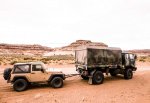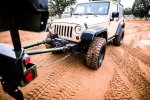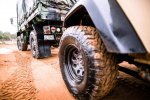aleigh
Well-known member
- 1,040
- 52
- 48
- Location
- Phoenix, AZ & Seattle, WA
Someone PM’d me for information on my experiences painting with CARC. I’ve posted bits and pieces before but I thought I’d just write up a guide. The first thing I want to say is that I am not an expert, it’s not like I was in the military painting things all day. To date I’ve done a couple of Jeeps and a trailer. I’ll probably be doing my LMTV within another year or two.
This entire guide is ONLY about the Water Dispersed (WD) 2-part CARC paint system, which is the current, modern system as of this writing. I know nothing about the application, use, or dangers of the older systems, or the systems used for plastics.
-= Where To Get It =-
CARC is produced by a couple of companies, and I get mine from Sherwin Williams. You can’t go into the store and buy it, they won’t know what you are talking about. It comes from their industrial coating division and so is ordered through a commercial sales guy. They will require you to register an account and provide a payment method like just about any commercial vendor but they had no vendor requirements, did not care if I was really a company, etc.
The minimum qty they would sell an order for is 4 gallons of one color, including the epoxy. The last time I bought the price was about $600 for the kit. Unopened the kit has a shelf life of about a year. Once opened, the shelf life of the epoxy is short – less than a month I recall – and the paint is longer, a couple of months. I took their shelf lives seriously and so I ended up buying another couple bottles of epoxy later to complete the project, for a price of about $135. A lot of people would probably say their shelf life is conservative but I didn’t want some problem with the job later.
The sales guy was easy to deal with and was maybe a little bemused at taking a tiny order from an individual, but really didn’t care. The paint is ITAR and that may be the case, but so is a ton of other stuff I own. The guy asked in passing what it was for and we said painting military vehicles.
-= Will It Kill You =-
There’s a lot of misinformation floating around about the dangers of CARC coating, I think partly beause of active imaginations, but also because of the older solvent CARC systems.
WD CARC is dangerous, but it’s exactly as dangerous is traditional 2-part (2K) automotive paints used every day in the body shop / paint industry. IF you have ever worked with a 2K system safely you are already equipped to work with CARC.
The hazard when working with wet CARC is isocyanates. There are two ways to remove this hazard. The first is to use a forced air hood. The second is to use a properly-fitted respirator mask with an isocyanate rated filter. I know of exactly one system: 3M 6000 with the 60921 Organic Vapor cartridges. The cartridges are rated for a certain amount of exposure time, so you need to keep track. If they pass isocyantes to you they are odorless so you will not know you have been exposed.
When dry, CARC particles (like sanding dust) are inert, but I would avoid breathing it just the same, like any dried paint product. Breathing ground industrial product is basically never good for you, which should be common sense.
READ ALL THE MANUALS AND WARNINGS FOR YOUR SAFETY EQUIPMENT
-= Where To Do It =-
I built a paint “booth” by hanging plastic sheeting from the rafters in a shop. If I had to do it again I’d do it outside in the desert on a low-wind day. We had a lot of pollen back in Washington so I’d be leery about doing it outside in those conditions. I used HDG fluorescents like are in the base-x tents for light and rigged up box fans to move fumes around. The CARC needs a minimum temperature to cure, which is in the instructions, I forget, but this is not a thing to do in winter in an unheated building.
-= How to Prep =-
I did a pair of Jeep JKs (including one that was brand new, like <100 miles. The Jeep dealer sure got confused when they buyer said she didn’t care what color it was because she was going to immediately paint it). For this application, I sanded down to the factory primer, and then cleaned and prepped with PPG products. For places where we accidentally sanded down to metal, I used either a SprayMax 2K-in-a-can primer or I spayed bulk PPG etching primer through a gun (described later).
I also sprayed CARC on the flexible plastic grills of the jeeps by prepping with PPG primer after the piece was etched with Bulldog adhesion promoter. If you go to a paint shop that specializes in automotive they’ll know just what to do if you tell them you need primer on a plastic body panel. They have held up fine.
The WD-CARC system has a specific CARC primer, but I got full adhesion on these commercial primers, which were significantly more convenient to buy. Whatever primer you use make sure it is a sealing primer because the WD CARC is porous to water. You need the primer to provide the waterproofing (as described to me).
I also did a trailer which had an old CARC paint job on it. I mostly painted it because I had the trailer in 3-color NATO and I had left over CARC so I figured why not, I’d shoot it for fun. The only thing I did to prep was to hose it off and sand down a couple of rust spots and then I just shot the whole thing. I didn’t de-grease it. The paint pulled in a couple of spots where there were clearly prep issues (like residual solvent, etc.) but overall it adhered really well. If you are doing a CARC on CARC project, just make sure to clean and degrease properly, and you will get a good result.
-= How to Spray =-
I sprayed with a HVLP gun. I looked at doing a HP gun off an air compressor but the CFM requirements of the guns would have required me to also purchase a huge air compressor. I purchased a Fuji 2804 system for $800 and I would recommend it to anybody. This is a self-contained system that has a little box like a reverse vacuum cleaner. It’s incredible, and you’ll thank me when it comes time to restain your deck or some furniture.
The Fuji manual has recommendations and instructions for doing the viscosity checks, and for what needle and head to use. I ended up using a needle combination that came with the gun for shooting the primer, and then I believe I ran the CARC through a #5 set. I wanted a really rough textured look, not smooth, and was able to easily achieve that.
You basically don your PPE, mix a shot of the paint, load the gun, and go. CARC is the most forgiving coating I have ever sprayed, I literally used paint brushes sometimes, and cleaned up mistakes with lintless rags. You could absolutely just roll it on with a paint roller if you want.
There are instructions on the cure times and temperatures. Basically the project needs to be held around room temperature and is dry to the touch in a few hours, but not fully cured for another day or two under ideal conditions.
I used regular paint thinner for cleanup on the gun and had no problems with cleaning the unit up. I used a metal tin and just removed the stainless steel parts from the gun in (disassemble!) and the CARC came right off.
-= Disposing =-
The paint you let dry and just throw away like latex paint. The epoxy goes to wherever your haz goes. In King County, Washington the hazmat waste transfer station took it for free and didn’t even blink.
-= Aftermath =-
The paint is incredible and is an ideal choice for these vehicles. I did the first Jeep because the factory paint had been scratched to death by years of off-roading. My CARC paint still looks fantastic years and tens of thousands of miles later. It is a constant source of attention and compliments. An unexpected side-effect is the vehicle stays considerably cooler to the touch in the sun – I’ve heard this is because the CARC is reflective into IR whereas traditional vehicle paints look black. I do have night vision and I can attest that the CARC paints multi-spectrally blend into the surrounding terrain, it’s really something actually. So far the paint has not really faded.
-= Photos =-
Jeep #1: https://www.flickr.com/photos/adventioneering/albums/72157651513050689
Jeep #2: https://www.flickr.com/photos/adventioneering/albums/72157655678438544
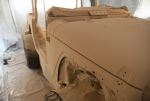
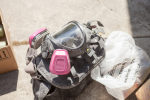
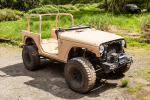
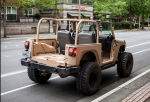
This entire guide is ONLY about the Water Dispersed (WD) 2-part CARC paint system, which is the current, modern system as of this writing. I know nothing about the application, use, or dangers of the older systems, or the systems used for plastics.
-= Where To Get It =-
CARC is produced by a couple of companies, and I get mine from Sherwin Williams. You can’t go into the store and buy it, they won’t know what you are talking about. It comes from their industrial coating division and so is ordered through a commercial sales guy. They will require you to register an account and provide a payment method like just about any commercial vendor but they had no vendor requirements, did not care if I was really a company, etc.
The minimum qty they would sell an order for is 4 gallons of one color, including the epoxy. The last time I bought the price was about $600 for the kit. Unopened the kit has a shelf life of about a year. Once opened, the shelf life of the epoxy is short – less than a month I recall – and the paint is longer, a couple of months. I took their shelf lives seriously and so I ended up buying another couple bottles of epoxy later to complete the project, for a price of about $135. A lot of people would probably say their shelf life is conservative but I didn’t want some problem with the job later.
The sales guy was easy to deal with and was maybe a little bemused at taking a tiny order from an individual, but really didn’t care. The paint is ITAR and that may be the case, but so is a ton of other stuff I own. The guy asked in passing what it was for and we said painting military vehicles.
-= Will It Kill You =-
There’s a lot of misinformation floating around about the dangers of CARC coating, I think partly beause of active imaginations, but also because of the older solvent CARC systems.
WD CARC is dangerous, but it’s exactly as dangerous is traditional 2-part (2K) automotive paints used every day in the body shop / paint industry. IF you have ever worked with a 2K system safely you are already equipped to work with CARC.
The hazard when working with wet CARC is isocyanates. There are two ways to remove this hazard. The first is to use a forced air hood. The second is to use a properly-fitted respirator mask with an isocyanate rated filter. I know of exactly one system: 3M 6000 with the 60921 Organic Vapor cartridges. The cartridges are rated for a certain amount of exposure time, so you need to keep track. If they pass isocyantes to you they are odorless so you will not know you have been exposed.
When dry, CARC particles (like sanding dust) are inert, but I would avoid breathing it just the same, like any dried paint product. Breathing ground industrial product is basically never good for you, which should be common sense.
READ ALL THE MANUALS AND WARNINGS FOR YOUR SAFETY EQUIPMENT
-= Where To Do It =-
I built a paint “booth” by hanging plastic sheeting from the rafters in a shop. If I had to do it again I’d do it outside in the desert on a low-wind day. We had a lot of pollen back in Washington so I’d be leery about doing it outside in those conditions. I used HDG fluorescents like are in the base-x tents for light and rigged up box fans to move fumes around. The CARC needs a minimum temperature to cure, which is in the instructions, I forget, but this is not a thing to do in winter in an unheated building.
-= How to Prep =-
I did a pair of Jeep JKs (including one that was brand new, like <100 miles. The Jeep dealer sure got confused when they buyer said she didn’t care what color it was because she was going to immediately paint it). For this application, I sanded down to the factory primer, and then cleaned and prepped with PPG products. For places where we accidentally sanded down to metal, I used either a SprayMax 2K-in-a-can primer or I spayed bulk PPG etching primer through a gun (described later).
I also sprayed CARC on the flexible plastic grills of the jeeps by prepping with PPG primer after the piece was etched with Bulldog adhesion promoter. If you go to a paint shop that specializes in automotive they’ll know just what to do if you tell them you need primer on a plastic body panel. They have held up fine.
The WD-CARC system has a specific CARC primer, but I got full adhesion on these commercial primers, which were significantly more convenient to buy. Whatever primer you use make sure it is a sealing primer because the WD CARC is porous to water. You need the primer to provide the waterproofing (as described to me).
I also did a trailer which had an old CARC paint job on it. I mostly painted it because I had the trailer in 3-color NATO and I had left over CARC so I figured why not, I’d shoot it for fun. The only thing I did to prep was to hose it off and sand down a couple of rust spots and then I just shot the whole thing. I didn’t de-grease it. The paint pulled in a couple of spots where there were clearly prep issues (like residual solvent, etc.) but overall it adhered really well. If you are doing a CARC on CARC project, just make sure to clean and degrease properly, and you will get a good result.
-= How to Spray =-
I sprayed with a HVLP gun. I looked at doing a HP gun off an air compressor but the CFM requirements of the guns would have required me to also purchase a huge air compressor. I purchased a Fuji 2804 system for $800 and I would recommend it to anybody. This is a self-contained system that has a little box like a reverse vacuum cleaner. It’s incredible, and you’ll thank me when it comes time to restain your deck or some furniture.
The Fuji manual has recommendations and instructions for doing the viscosity checks, and for what needle and head to use. I ended up using a needle combination that came with the gun for shooting the primer, and then I believe I ran the CARC through a #5 set. I wanted a really rough textured look, not smooth, and was able to easily achieve that.
You basically don your PPE, mix a shot of the paint, load the gun, and go. CARC is the most forgiving coating I have ever sprayed, I literally used paint brushes sometimes, and cleaned up mistakes with lintless rags. You could absolutely just roll it on with a paint roller if you want.
There are instructions on the cure times and temperatures. Basically the project needs to be held around room temperature and is dry to the touch in a few hours, but not fully cured for another day or two under ideal conditions.
I used regular paint thinner for cleanup on the gun and had no problems with cleaning the unit up. I used a metal tin and just removed the stainless steel parts from the gun in (disassemble!) and the CARC came right off.
-= Disposing =-
The paint you let dry and just throw away like latex paint. The epoxy goes to wherever your haz goes. In King County, Washington the hazmat waste transfer station took it for free and didn’t even blink.
-= Aftermath =-
The paint is incredible and is an ideal choice for these vehicles. I did the first Jeep because the factory paint had been scratched to death by years of off-roading. My CARC paint still looks fantastic years and tens of thousands of miles later. It is a constant source of attention and compliments. An unexpected side-effect is the vehicle stays considerably cooler to the touch in the sun – I’ve heard this is because the CARC is reflective into IR whereas traditional vehicle paints look black. I do have night vision and I can attest that the CARC paints multi-spectrally blend into the surrounding terrain, it’s really something actually. So far the paint has not really faded.
-= Photos =-
Jeep #1: https://www.flickr.com/photos/adventioneering/albums/72157651513050689
Jeep #2: https://www.flickr.com/photos/adventioneering/albums/72157655678438544








